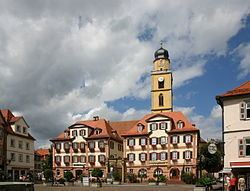Time zone CET/CEST (UTC+1/+2) Population 22,505 (31 Dec 2008) | Postal codes 97980 Local time Tuesday 12:48 AM | |
 | ||
Weather 8°C, Wind SW at 29 km/h, 87% Humidity Points of interest Tauber, Bad Mergentheim Wildlife P, Innerer Schlosshof, Deutschordensmuseum, Erholungs‑ und Freizeitpa | ||
Bad mergentheim markenfilm
Bad Mergentheim ( listen ; Mergentheim until 1926) is a town in the district Main-Tauber-Kreis district in the German state of Baden-Württemberg.
Contents
- Bad mergentheim markenfilm
- Map of 97980 Bad Mergentheim Germany
- Sch nheiten von bad mergentheim an der tauber
- History
- Villages
- Main sights
- Modern facilities
- Twin towns sister cities
- Notable residents and natives
- References
Map of 97980 Bad Mergentheim, Germany
Sch nheiten von bad mergentheim an der tauber
History
Mergentheim is mentioned in chronicles as early as 1058, as the residence of the family of the counts of Hohenlohe, who early in the 13th century assigned the greater part of their estates in and around Mergentheim to the Teutonic order. In 1340 Mergentheim got Town privileges. It rapidly increased in fame, and became the most important of the eleven commanderies of that society. On the secularization of the Teutonic Order in Prussia in 1525, Mergentheim became the residence of the grand master, and remained so until the final dissolution of the order in 1809 by Napoleon.
Bad Mergentheim's fortunes were reversed in 1826, when a shepherd by the name of Franz Gehring discovered rich mineral springs in the surrounding area, during the time when spas were expanding in Germany at a rapid pace. The water turned out to be the strongest sodium-sulfate water in all of Europe, especially effective for the treatment of digestive disorders.
In the 1970s several neighbouring villages were incorporated during the "Gemeindereform".
Villages
(inhabitants)
Althausen (600), Apfelbach (350), Dainbach (370), Edelfingen (1.400), Hachtel (360), Herbsthausen (200), Löffelstelzen (1,000), Markelsheim (2,000), Neunkirchen (1,000), Rengershausen (480), Rot (260), Stuppach (680), Wachbach (1,300)
Main sights
The most interesting sight in Bad Mergentheim is the Deutschordensschloss, the medieval castle where the Teutonic Knights once had their home base. It is a complex of buildings built over a period of eight hundred years. The first buildings of the castle were probably erected as early as the 12th century. The castle was expanded in the late 16th century under Grand Master Walter von Cronberg. Over the course of time a representative Renaissance complex was built by connecting the individual buildings in the inner palace courtyard to a closed ring of buildings. In 1574, the main architect, Blasius Berwart, also constructed the spiral staircase between the west and north wing still famous today. Today the castle houses the Deutschordensmuseum (Museum of the Teutonic Order).
The castle complex is dominated by the Schlosskirche (Castle Church), built in 1730 in Baroque style. Its Rococo interior features elaborate ceiling frescos by the court painter Nikolaus Gottfried Stuber, depicting The Defense of Faith, the Glorification of the Cross in Heaven and on Earth and the Emperor Constantine's Vision of the Cross. Almost 200 years ago the Schlosskirche became a Protestant church.
Modern facilities
Twin towns — sister cities
Bad Mergentheim is twinned with:
